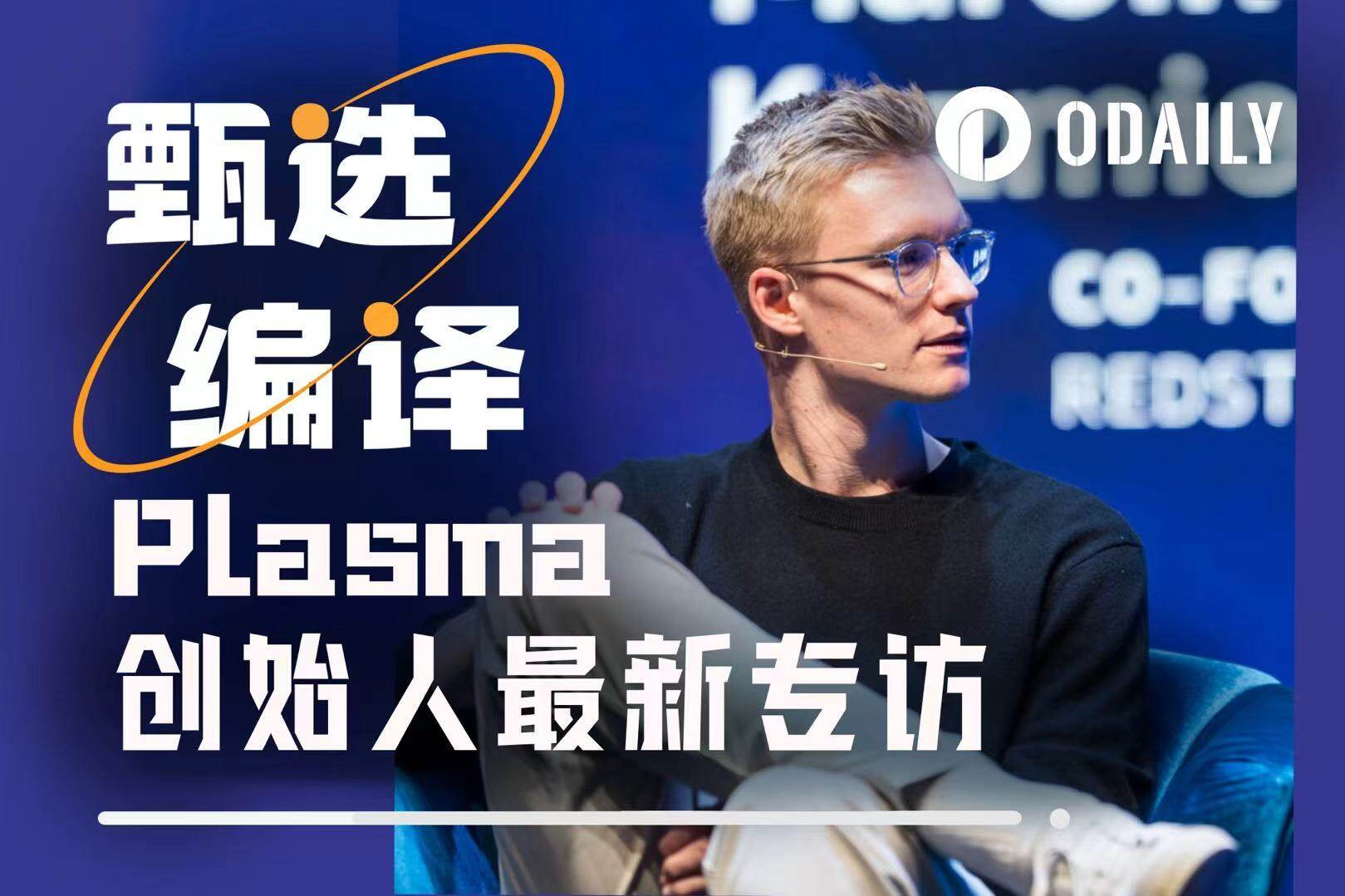Plasma’s Stablecoin Dream Story: The 26-Year-Old Founder Tells How to Build the Strongest Project of This Round
Odaily Planet Daily کے ذریعہ مرتب کردہ ( @OdailyChina ); Translated by Azuma ( @azuma_eth )
Editor’s Note: Plasma officially launched its mainnet and held its TGE last week. Its opening market capitalization of tens of billions of dollars created a new round of wealth creation. The generous airdrop in particular earned Plasma the accolade of “the most ambitious project of this round.”
On September 26th, Paul Faecks, the 26-year-old founder and CEO of Plasma, sat down for an exclusive podcast interview with The Rollup. During the interview, Paul addressed specific questions, including the motivation behind the Plasma airdrop, his strategy for retaining TVL, XPL’s value capture, and Plasma’s future development plans. The following is Paul’s original podcast transcript, translated by Odaily.
- Host: Welcome, Paul! How have you been these past few days?
Paul: This week has been pretty intense overall. Launching a new blockchain always involves a lot of external factors that aren’t entirely under our control , but so far so good. Yesterday was pretty exhausting for everyone, though.
- Host: Is the most difficult stage over?
Paul: Not yet. We just officially announced the Plasma One product, and the real construction has just begun. Chains, DeFi, exchange components, and so on—it’s a massive system. (Frustrated) Oh my god, we have so much to do in the next few years.
- Moderator: How did you come up with the idea of designing such an XPL distribution plan? For example, the viral activity of “deposit $1 and get $10,000 in XPL” made many people rich, and I think it also helped you avoid a lot of FUD.
Paul: I think this is generally in line with our usual way of operating. Our previous public sales rules were very clear and the parameters were very transparent, and basically anyone could participate.
It was very important for us to enter the market in a way that enabled broad participation. Ultimately, something like a stablecoin blockchain requires people to genuinely want to use it, and you need it to truly develop from the bottom up in order for it to truly be effective and generate value.
- Host: Let’s talk about the current situation. What are the current revenue opportunities on the Plasma chain that are worth noting? How can we ensure that the returns from XPL incentives are sustainable, rather than just “dig in and run”?
Paul: We always knew that distribution was critical to achieving ubiquitous coverage, and even more so as a stablecoin chain.
I think one thing that might be overlooked is that we had a pretty large and scalable partnership with Binance Earn before the network launched. Binance has 280 million users, and they can now deposit assets built on Plasma directly on the exchange, which is a huge breakthrough for us.
We are looking for ways to achieve large-scale distribution. To the extent that you can’t rely solely on کرپٹو-native “nomadic liquidity” because their scalability is limited and these liquidity is quite fickle, you can’t build a strategy around them alone.
Sorry, I don’t want to sound like I’m answering the question off topic… Back to the sustainability of Plasma DeFi. I think the most important factor is building real organic use cases, not pure fee incentives.
- Host: Do you have anything that others don’t have?
Paul: The best team in the crypto industry.
- Host: So that’s your moat? My question is, do you foresee other teams trying to replicate this?
Paul: I truly believe we have a truly incredible team.
It would probably be unfair for me to mention anyone’s name here because I can’t mention everyone…especially Lucid, she’s the best COO in the industry, Nathan is amazing, Vinnie does an amazing job too, and sorry I started naming names but I’m sure I’ll miss some people.
I really think it’s a huge, huge moat. Having incredibly sharp people who have a long-term vision and who truly want to build something valuable is, in my opinion, the greatest moat any company can have.
- Host: Currently, in the stablecoin blockchain competition, several major players, such as Circle, Stripe, and Tether, are vying to become the world’s stablecoin delivery layer. Last week, we had Circle founder Jeremy Allaire on the show, and he mentioned his hope of making USDC as ubiquitous as Netflix. He mentioned his desire to integrate stablecoins into a broader technology stack, just as we can use Chrome on any device. He has a “joint effort to expand the pie” mentality. So, I’d like to ask you: when you think about this “stablecoin blockchain war,” how do you view the competitive landscape? Considering Plasma’s early market position, what are your advantages? In this context of “joint effort to expand the pie,” what contribution do you think Plasma can make?
Paul: The growth of stablecoins has just begun. The current scale is less than 300 billion US dollars, but it will be trillions in the future.
When we started, the questions we heard weren’t “how are you going to compete with Stripe”, but “what’s the point of anything you’re doing here”, “why do stablecoins need a chain”, “wouldn’t it be better to just use Ethereum”?
تو، it’s very gratifying to see the market’s perception of who we’re competing with change, and I think it reflects the evolution of the industry . We do compete with Stripe, one of the largest payment companies in the world, but I think we’re ultimately pursuing different things and have different approaches to achieving them, so I wouldn’t consider us to be in direct competition with Tempo (Stripe’s blockchain).
I believe winning this war on a truly large scale will be an absolutely uphill battle, and no one has yet achieved it. I sincerely don’t believe Ethereum and Tron have yet achieved a large-scale victory, because the so-called “scale” today will no longer be “scale” in two or three years. In the future, there will be stablecoin chains that support hundreds of billions of dollars in stablecoins, with trillions of dollars flowing every day. This is the future we are striving for.
I wouldn’t get too hung up on what competitors like Tempo and Codex are doing. I have huge respect for them and they’re very sharp, but to some extent we’re pursuing different things.
- Host: Let’s talk about Plasma One. What is the vision for this product? If you saw a headline about a Plasma One application five years from now, how would you like that headline to describe it?
Paul: I believe stablecoins, as a core infrastructure, are the perfect technology stack for building consumer products. For us, on the one hand, they are clearly a distribution gateway; on the other hand, I also believe they can truly provide users with a better financial experience.
I’m a long-time stablecoin user. While I live in an environment with a fairly robust banking system and relatively good access to financial technology, I think that’s not the case for most of the world. Building new products based on stablecoins allows you to create a much better experience than traditional banking channels, which is part of the reason we built Plasma One.
- Host: Could you elaborate a little bit more on the concept of a “distribution portal”? I’m familiar with it, but I haven’t heard it articulated the way you’ve just described it. Could you perhaps explain the concept and how you’re applying it?
Paul: Stablecoin chains are highly dependent on network effects. You need to be ubiquitous and have extremely broad coverage. In fact, what Tron is good at or has been good at is achieving true end-user distribution, so this is critical for us.
For us, the path to achieving that is to have a very concrete thing that actually uses Plasma itself, and Plasma One is at least part of that.
We are particularly focused on user experience. Target markets include Turkey, Syria, Brazil, Argentina, and others, where users demand frictionless transfers and privacy, rather than complex wallet seed phrases and on-chain approval processes. Plasma One is committed to providing an experience comparable to, or even better than, traditional payment systems.
- Host: How will XPL achieve value accumulation? I’m not asking about where the price of XPL will go, but more about how XPL can become a sustainable asset. I know some holders want to compare it to Circle or other payment giants’ stocks. They see XPL as the best way to gain stablecoin exposure. How can you help XPL holders achieve this?
Paul: XPL must be the core of the Plasma economy. We will not pursue a path that fragments the ecosystem and disperses value. We will gradually release details, but what is certain is that XPL will play a central role in the ecosystem and remain highly aligned with the community.
- Host: Tether’s co-CEO, Paolo Ardoino, sent a tweet a few days ago… In an interview, someone asked him, if a company’s growth stage is defined from 0 to 100, where is Tether? He replied that it is still at 0.25… There have also been recent rumors that Tether is raising $20 billion at a $500 billion valuation.
How important is Tether to Plasma?
Paul: First of all, let’s be clear. If Tether is at 0.25 now, then we may be at 0.00001 , and we still have a lot of work to do.
Tether has clearly built a truly epoch-making company, having made many long-term decisions over many years of hard work. These experiences are worth emulating for Plasma.
I think USDT has largely won the stablecoin game. That’s my opinion, and I might be a bit biased, so you can discount it a bit, but I genuinely believe that’s the case. It’s always been clear to us that Plasma would be built around USDT. We have multiple stablecoins on our chain, and I obviously believe in a multi-stablecoin future, but Tether is so incredibly dominant and has this incredibly wide distribution moat that I think it’s going to be hard to replicate.
We truly admire them and thoroughly enjoy working with them. I have the deepest respect for Paulo and the entire Tether team.
- Host: Last question, if someone is just learning about Plasma, what would you like them to know?
Paul: One thing I want everyone to know is that we are going to win the stablecoin war. I think stablecoins will become one of the largest markets in the world, literally. The total addressable market is the global GDP. All future commerce will be run on stablecoins, and Plasma will power it.
یہ مضمون انٹرنیٹ سے لیا گیا ہے: Plasma’s Stablecoin Dream Story: The 26-Year-Old Founder Tells How to Build the Strongest Project of This RoundRecommended Articles
Decentralized finance (DeFi) has become a core application of Web 3, but its development still faces several practical challenges: Ethereum’s high gas costs, the fragmented experience between Layer 2 protocols, the security risks of cross-chain bridges, and the difficulty of centralizing liquidity. According to DeFiLlama data, nearly all of the top ten protocols by TVL are based on the EVM, demonstrating that the EVM has become the de facto industry standard. Against this backdrop, Polkadot Hub has chosen a more pragmatic roadmap for 2025: first launching a 100% EVM-compatible execution environment (RustEVM) to enable seamless migration of applications on Ethereum, while continuing to develop the RISC-V-based PolkaVM to prepare for more complex and high-performance applications in the future. This isn’t a simple compromise, but rather a strategic choice based on…







